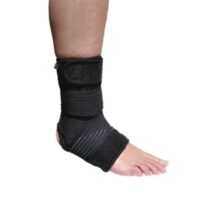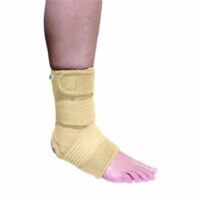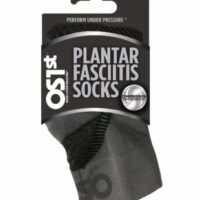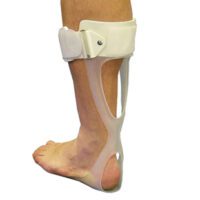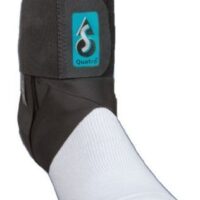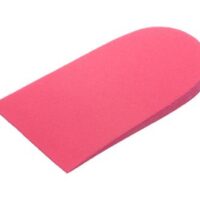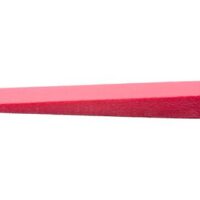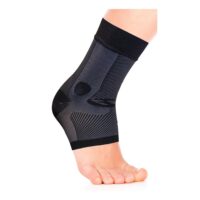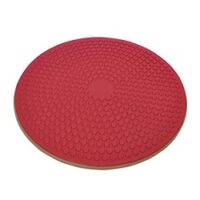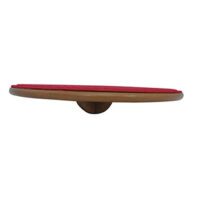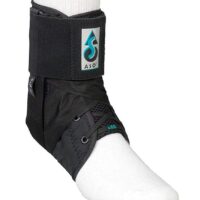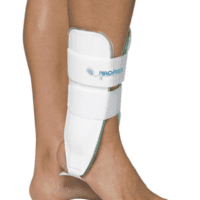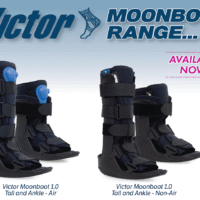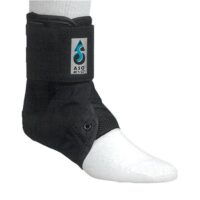Retrocalcaneal Bursitis
Article by John Miller

Retrocalcaneal Bursitis
(Heel Bursitis)
What is Retrocalcaneal Bursitis?
Retrocalcaneal bursitis is the most common heel bursitis.
Retrocalcaneal bursitis is inflammation of the bursa (a small, cushioning sac located where tendons pass over areas of bone around the joints), which lies over your heel (calcaneum) where your Achilles tendon inserts.
What is Bursitis?
What are Retrocalcaneal Bursitis Symptoms?
You may experience one or more of the following symptoms:
- Pain and swelling are occurring over the rear of your heel.
- Pain when you are leaning on your heel, e.g. sitting with heels on the ground.
- Increased pain when using your calf muscles. e.g. running, walking, calf raises
What Causes Retrocalcaneal Bursitis?
The retrocalcaneal bursa may be inflamed by your Achilles tendon rubbing over the bursa and causing friction against the heel bone. This injury can occur traumatically from a fall or a sport-related impact contusion.
It can also be a gradual onset via a repetitive trauma to the bursa from activities such as running and jumping (with inferior muscles control or technique) or excessive loading on your heel.
It is also a secondary injury associated with chronic conditions such as:
How is Retrocalcaneal Bursitis Diagnosed?
Your physiotherapist or doctor will provide you with an assessment of your medical history and a physical examination of your heel and ankle. A hallmark sign is swelling or tenderness of your heel around the insertion of your Achilles tendon.
Medical imaging techniques that include ultrasound scan & MRI confirm your diagnosis.
What is Retrocalcaneal Bursitis Treatment?
Ice
Bursitis is an inflamed bursa. Daily application of ice packs is highly recommended to reduce your pain and swelling.
Medications
NSAIDs or anti-inflammatory drugs (i.e. ibuprofen). Use of these medications should be discussed with your doctor.
Corticosteroid Injections
Single injection of a corticosteroid with a local anaesthetic into the bursa may be required to stimulate your healing response. It is preferable to have this injection using ultrasound guidance.
Retrocalcaneal Bursitis Treatment
PHASE I – Pain Relief & Protection
Managing your pain. Pain is the main reason that you seek treatment for retrocalcaneal bursitis. In truth, it was actually the final symptom that you developed and should be the first symptom to improve.
Managing your inflammation. Bursa inflammation is best eased via ice therapy and techniques or exercises that de-load the inflamed structures.
Your physiotherapist will use an array of treatment tools to reduce your pain and inflammation. These include: ice, electrotherapy, acupuncture, de-loading taping techniques, soft tissue massage etc.
PHASE II – Restoring Normal ROM, Strength
As your pain and inflammation settles, your physiotherapist will turn their attention to restoring your normal ankle joint range of motion, muscle length and resting tension, muscle strength, endurance and proprioception.
Please ask your physio for their advice.
PHASE III – Restoring Full Function
The final stage of your rehabilitation is aimed at returning you to your desired activities. Everyone has different demands for their lower limbs that will determine what specific treatment goals you need to achieve.
Your physiotherapist will tailor your elbow rehabilitation to help you achieve your own functional goals.
PHASE IV – Preventing a Recurrence
Retrocalcaneal bursitis can return if you annoy your bursa. The main reason it is thought to recur is due to insufficient rehabilitation or not understanding your condition.
Retrocalcaneal Bursitis Surgery
Surgery is not a common path. However, in persistent cases, removal of the bursa – known as a bursectomy – can be performed.
How Can You Prevent Retrocalcaneal Bursitis?
Muscle weakness or fatigue is a potential cause of retrocalcaneal bursitis. So addressing your strength and endurance is necessary to avoid a recurrence.
What Results Can You Expect for Retrocalcaneal Bursitis?
While some people can respond quickly to physiotherapy treatment within a few weeks, more chronic cases where an Achilles tendinopathy, plantar fasciitis, heel spur or other lower limb injury co-exists, can require a few months to achieve recovery.
Retrocalcaneal bursitis is successfully managed in the vast majority over a period of approximately six weeks. It is important to not stop your rehabilitation exercises as soon as your pain abates. Hydrocortisone injections may be helpful in the short-term to reduce the inflammatory response within the bursa.
Please follow the advice of your physiotherapist or doctor.
Rochedale - Call 38410277
Book Online: RochedaleSalisbury - Call 32751044
Book Online: SalisburySandgate - Call 32691122
Book Online: SandgateCommon Causes of Ankle Pain
Introduction
Welcome to our detailed guide on the common causes of ankle pain. As physiotherapists, we understand how various conditions and injuries can lead to discomfort in your ankle. From sprains to degenerative diseases, this guide aims to provide clear insights for the general public on navigating these issues.
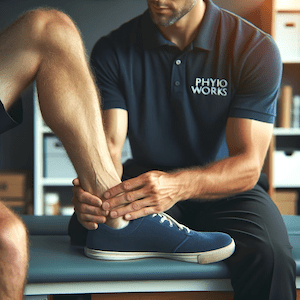

Sprained Ankles and Syndesmosis Injuries
Sprained ankles, including syndesmosis injuries, are among the most common issues we encounter. These injuries can range from mild ligament stretches to severe tears, impacting your mobility and quality of life. Understanding the specifics of each type is crucial for effective treatment and timely recovery.
Ankle Tendinopathies
Tendinopathies, such as those affecting the Achilles and tibialis posterior tendons, are common in active individuals. These conditions arise due to overuse or trauma, leading to pain and swelling in the affected area. Targeted physiotherapy can significantly aid in recovery and prevent future injuries.
Posterior Ankle Conditions
Conditions like posterior ankle impingement and retrocalcaneal bursitis can cause significant pain, especially during physical activities. Recognising these conditions early and starting appropriate treatment is vital for maintaining ankle health and functionality.
Ankle Arthritis
Arthritis in the ankle, often a result of wear and tear or injury, leads to joint pain and stiffness. Early intervention and proper management, including physiotherapy, are essential to slow its progression and manage symptoms effectively.
Biomechanical Conditions
Abnormal foot and ankle biomechanics can lead to various issues, from pain during weight-bearing to nerve compression. Understanding and treating these conditions are crucial for restoring normal function and preventing further complications.
Systemic Conditions That May Cause Ankle Pain
Systemic diseases such as rheumatoid arthritis can manifest as ankle pain. It's important to address these underlying conditions to effectively manage ankle symptoms.
Conclusion
Ankle pain can arise from a multitude of causes, each requiring a unique approach to treatment. If you're experiencing ankle discomfort, we recommend consulting a physiotherapist or doctor for a thorough evaluation. A personalised care plan can significantly improve your quality of life and mobility.
Related Articles
- Sprained Ankle Treatment & Recovery Guide - This article provides comprehensive information on managing pain and inflammation for a sprained ankle, including initial RICE steps and exercises for restoring mobility.
- Anterior Ankle Impingement: Causes, Treatments, Tips & Guide - Offers insights into the causes of anterior ankle impingement, its treatments, and practical tips for management.
- Posterior Ankle Impingement: Causes & Treatments - Explains the condition of posterior ankle impingement, its causes, and available treatment options.
- Tibialis Posterior Tendinopathy - Discusses the condition affecting the tibialis posterior tendon, symptoms, and implications for foot arch pain and ankle stability.
- Achilles Tendinopathy - Answers frequently asked questions about foot and ankle pain associated with Achilles tendinopathy and provides an overview of tendon injuries.
- How To Strap An Ankle - Guides on the correct techniques and types of tape for ankle strapping to prevent or manage ankle injuries.
Rochedale - Call 38410277
Book Online: RochedaleSalisbury - Call 32751044
Book Online: SalisburySandgate - Call 32691122
Book Online: SandgateFoot, Ankle & Heel Pain FAQs
Introduction
Welcome to PhysioWorks' comprehensive FAQ page on Foot, Ankle, and Heel Pain. Our expert physiotherapists are here to guide you in managing and overcoming discomfort. We’ve organised the FAQs into categories, each with a brief overview and links to in-depth articles, making navigation and understanding easier for you.


Foot Pain
Step into the various causes of foot pain and learn effective ways to relieve discomfort. Understand the impact of activities like barefoot running.
Ankle Injuries
Explore common ankle injuries and how to address them. From sprains to ligament damage, find out the best practices for care and prevention.
Heel Pain
Uncover the reasons behind heel pain and the effective treatments available. This section is particularly useful for understanding conditions like plantar fasciitis and heel spurs.
Achilles Pain
Find out how to manage and treat Achilles tendinopathy, a common concern for athletes and active individuals.
Shin Pain
Learn about shin splints, their causes, and how to alleviate this common issue, especially among runners.
Youth Injuries
Gain insights into youth leg injuries, including growing pains and heel issues in children.
Balance & Proprioception
Enhance your balance and proprioception with our professional advice and exercises.
Rochedale - Call 38410277
Book Online: RochedaleSalisbury - Call 32751044
Book Online: SalisburySandgate - Call 32691122
Book Online: SandgateRelated Articles
- Sprained Ankle Treatment & Recovery Guide: Offers detailed advice on how to manage sprained ankles, including immediate recovery steps and physiotherapy treatments.
- Ankle Pain: Effective Management And Treatment Options: Discusses various conditions leading to ankle pain and outlines effective treatment strategies, highlighting the role of physiotherapy in pain reduction and mobility improvement.
- Plantar Fasciitis: Provides an overview of plantar fasciitis, including common causes, treatment options, and related conditions like peroneal tendinopathy and Achilles tendinopathy.
- Achilles Tendinopathy: Focuses on the causes of Achilles tendinopathy, its impact on heel pain, and a range of treatment and prevention strategies.
- Ankle Strapping: Complete Guide To Injury Prevention: Explains the benefits of ankle strapping as a preventative measure against injuries, with a focus on techniques and materials.
- Heel Pain: Explores various causes of heel pain, including tendon injuries, foot injuries, bone injuries, and systemic conditions, alongside recommended treatments.











